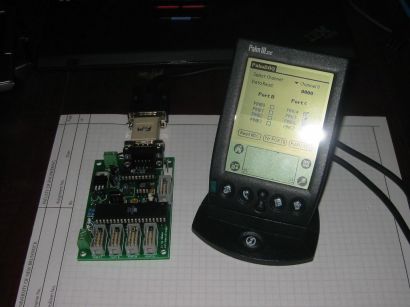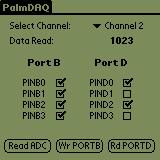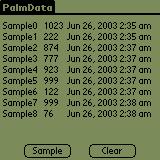
I've updated the article's source code and schematics to work with a small PCB breakout board. Lots of people emailed looking for something they could use with their projects, so hopefully this will help out. Check out my new Palm ADC page for more information.
This page supports a article written for the October 2003 (Issue 159) edition of Circuit Cellar. Updated and original versions of the source code and binaries are available. Circuit Cellar has their magazine archives available in electronic form, and I highly recommend that any electronics enthusiast take advantage of this wealth of information. If you are looking for the full text, diagrams, and information, they have electronic versions available at a nominal cost.
The full text of the article includes information on how to get started with the Atmel STK development board and will be of use to someone with minimal embedded development experience. Circuit Cellar has it available for online purchase in PDF format.
The article covers the basics of using a Atmel microcontroller as an interface between a data collection source and a storage and display device, the Palm unit. Examples are provided to allow for rudimentary serial communication, along with a graphical display of results, and a means to store samples in the Palm's database filesystem. These are sample programs I wrote to understand the concepts needed to develop some intelligent electronic instrumentation for my car. Also, a brief tutorial in how to configure the open source tools for programming the Atmel AVR series microcontrollers and the Palm devices is included.
If you do anything interesting with this project, or have any questions or ways to improve it, by all means let me know. I'm always interested in helping solve new and interesting problems. If this project has helped or inspired you, drop me a line too, because I certainly don't do this for the money. *grin*
Schematic
An updated schematic using a more commonly available MAX233 level converter can be downloaded. The MAX233 has the same benefit as the Dallas Semiconductor chip, no external capacitors required, but is a cheaper, stocked part at digikey.
PCB
A PCB is available for the updated schematic. I will post the layer images shortly. If you are interested in getting a board, email me. I believe the cost will be around $15us if I get enough requests. It will enable you to get started with programming data acquistion applications for the palm, and has a ISP header to allow direct programming. I am also working on a BOM with the digikey part numbers for those who are interested.
Software
The software has been tested on a Palm IIIxe device. It should have no problems on earlier versions of PalmOS, however, I don't have one of the newer units to test compatibility.


This is the uncleaned, largely uncommented code used to develop the concepts discussed in the article. I have provided working binaries for the ATMega163 and binaries that have been tested on a unmodified Palm IIIxe device. This software is provided without warranty and at your own risk.
Cleaned-up and commented versions that may be more suitable for educational use will be available once I have time to test them fully. The source is relatively straightforward and small, so the knowledable reader should be able to gain some utility. In the interim, if you have any questions, please email me and I will help as best I am able.
Steve Manley (smanley@nyx.net)
Last Modified: October 8, 2003